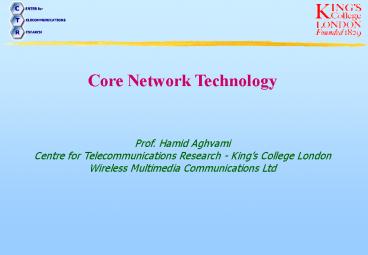Core Network Technology - PowerPoint PPT Presentation
Title:
Core Network Technology
Description:
One of the priority policy areas of the government-led 'e-Japan' ... Radical changes to existing IETF protocols and the IP layer model will be required. ... – PowerPoint PPT presentation
Number of Views:56
Avg rating:3.0/5.0
Title: Core Network Technology
1
Core Network Technology Prof. Hamid
Aghvami Centre for Telecommunications Research -
Kings College London Wireless Multimedia
Communications Ltd
2
Outline of Presentation
- Fixed IP-based Core Networks
- Mobile Core Networks
- IP-based IMT Network Platform( IP2 )
- Research Challenges
- Inter-working Issues
- Co-operation between UK and Japan
3
IP-based Fixed Network
- One of the priority policy areas of the
government-led e-Japan - programme is the establishment of an ultra
high-speed network - infrastructure.
- It has set goals to provide 24-hour connection
to high-speed Internet - access networks for at least 30 million
households and ultra high-speed - Internet access networks (30-100 Mb/s) for 10
million households - within 5 years.
- It has also set a deadline of 2005 for the
deployment of IPv6 in all public - and private networks.
- The government has lowered the tax on IPv6
equipment.
- All IP equipment currently manufactured by
Japanese manufacturers has - dual protocol stacks, both IPv4 and IPv6.
- The RD activities in IP-based networks are
founded on the recent IETF - protocols and recommendations.
4
Mobile Networks
Beyond 3G
3G
2G
1G
Phase I (3.5G)
Phase II (4G)
USA
AMPS
ANSI-41
Evolved ANSI-41
Evolved ANSI-41
Japan
MCS
PDC
IMS
Evolved GSM/GPRS
Evolved GSM/GPRS
NMT
Europe
GSM/GPRS
TACS
IP2
Internet
IPV6
IPV4
Evolution of Mobile Networks and Internet
5
IP2 Ad-Hoc Study Group
ITU-R WP8F
ITU-T IMT SSG
3GPPs, WWRF, IETF
TTC
ARIB
Long-term All IP Conference
(Telecommunication Technology Committee)
(Association of Radio, Industry and
Business )
Radio Experts
IT/NW Experts
IP2 Ad-Hoc
Study Group Structure
6
IP2 Ad-Hoc Study Group
Chairman Dr. Masami YABUSAKI (NTT
DoCoMo) Vice-chairmen Mr. Kazuyoshi SATO
(Mitsubishi) Dr.
Masayoshi OHASHI (KDDI)
Member Companies NTT DoCoMo, Inc., Toshiba
Corporation, KDDI Corporation,
Seiko Epson Corporation, J-Phone Co.,
Ltd., Sony Corporation, Nippon Ericsson
K.K. KYOCERA Corporation, Fujitsu
Limited, Mitsubishi Electric Corporation, Lucent
Technologies Japan Ltd., CRL, NEC
Corporation, NTC (Nippon Telecommunications
Consulting Nippon Motorola Ltd., Co.,
Ltd.), Nokia-Japan Co., LTD., NTT
SOFT, NTT, QUALCOMM JAPAN, OKI Electric
Industry Co., Ltd., DENSO Corporation, SHARP
Corporation, Hitachi
Ltd., Siemens K.K. NTT Communication
Corporation. Matsushita Communication Industrial
Co., Ltd
7
IP-based IMT Network Platform
IP-based IMT Network Platform ( IP2 ) main
requirements
- Huge multimedia traffic handling.
- Diversified radio access support.
- Advanced mobility management.
- Seamless/ubiquitous services
8
IP-based IMT Network Platform
Applications
AP2
AP3
APn
AP1
Middleware
Service support sub-layer
Location
Accounting/billing
Media conversion
Distribution
Basic network management sub-layer
RRM
MM
C/SM
Security
QoS
ISDN/ PSTN
IP-based transport NW
IP
IP
IP
IP
Internet
Radio
IP
IP
IP
Radio
Radio
General architecture of the IP-based IMT network
platform
9
Research Challenges
- Full integration and convergence of mobile and
Internet networks. - - Common mobility management
- - Efficient and dynamic re-routing within the
Internet for moving terminals - Separation of location management and routing
management
- Design of middleware layer
- - Separation of basic network control from
transport - Interaction between service support sub-layer
and applications and - between service support and basic network
management sub-layers.
- No separation between RAN and CN.
- Common interface between radio resource
management and other - network control entities
10
Research Challenges
The greatest challenge is not a technical one
it is how to influence the IETF to adopt the
common protocols and functionalities required for
IP2 . Radical changes to existing IETF protocols
and the IP layer model will be required.
11
Inter-working Issues
- The inter-working of WLAN and 3G cellular
networks is fully recognised - and some study and research work have already
been carried out.
- Although the benefit of inter-working between
broadcast and cellular - networks has been recognised, no research
activities have yet been - announced or reported.
- The use of WLAN equipment based on IEEE 802.11b
is common in Japan - within private networks and it seems that
IEEE 802.11a will follow it.
- Recently, NTT Communications Corp. has launched
its WLAN public - services.
12
Co-operation between UK and Japan
- Co-operation was proposed between UK and Japan
in the areas of - - Future network vision and its general
requirements. - - Evolution scenario from IMT-2000 networks.
- - Common global standardisation organisations
and schedules.
- Co-operation was also proposed between the IP2
Ad Hoc Study Group and - Mobile VCE.































